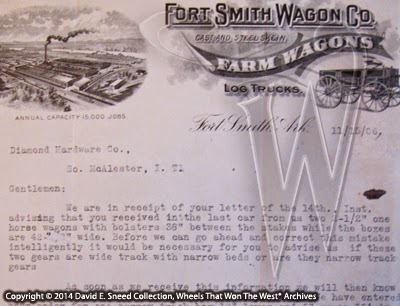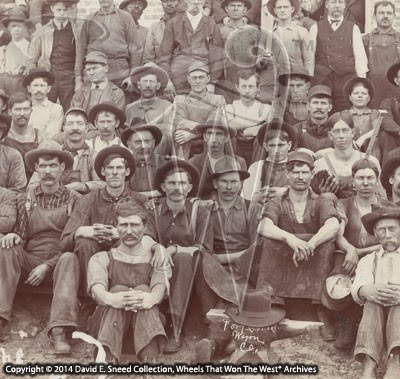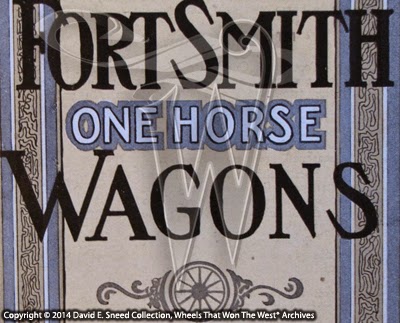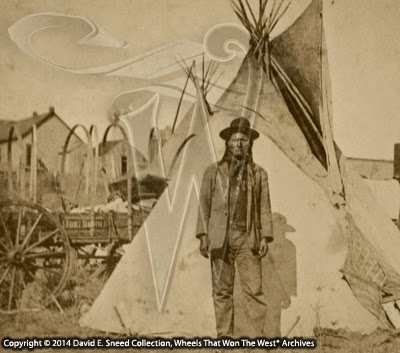My last few blog posts have predominantly dealt with early wood-wheeled vehicles found on the West Coast. So, this week, it seemed appropriate to venture back toward the rising sun and balance things out a bit. To those looking for a rhyme or reason as to how I determine each week's topic, I'm afraid you're out of luck. Like many, my world seems to run full throttle. So, most weeks, I'm simply on a quest to stay one step ahead of another posting deadline. Subject ideas can come from any number of places. Once determined, I go to work fleshing out the short story, preparing imagery, and scheduling the finished piece.
As I began pondering this week's subject, it occurred to me that, of all the blogs and articles I've written, I don't believe I've ever penned anything on an Arkansas wagon maker. As a native of the region, that oversight is to my shame I suppose. So, to make things right and give The Natural State its its due, I thought I'd share a bit about a legendary builder from the northwest corner of the state.
 |
| This letter from the Fort Smith Wagon Company dates to November of 1906, approximately 6 months before the firm was purchased by John Deere. |
Located on the banks of the Arkansas River, the modern day city of Fort Smith is steeped in America's western history and lore. During the nineteenth century, it was the last bastion of U.S. law before crossing into IndianTerritory. Even so, it was still home to its share of saloons, brothels, outlaws, drifters, and ne'er do wells. Any less-than-legal shenanigans, though, were balanced out by the firm-handed justice of 'Hanging Judge' Issac Parker who served as U.S. District Judge for more than two decades beginning in 1875. The judge passed away while still serving in1896. Seven years later, the Fort Smith Wagon Company was formed.

This extremely rare photo has been cropped to show more details of employees from the Fort Smith Wagon Company. The original image shows more than 70 workers outside the factory.
Organized in 1903, the Ft. Smith brand got its start after individuals in the city heard about an opportunity to purchase the equipment and assets of the South Bend Wagon Company in Indiana. Established two decades earlier, South Bend had been a strong marketer and promoter but as times began to change so did its profitability.
Once the new factory was up and running in Arkansas, it didn't take long to attract the attention of John Deere's branch houses. In 1905, a number of those distribution outlets began selling Fort Smith wagons. Within a couple more years, the branch houses joined forces with the home office to buy the Fort Smith firm. It was the first acquisition of an outside company by John Deere.1 In1910, Deere took the next step by purchasing all of the shares of the wagon company. Clearly, Fort Smith's location near quality hardwood forests as well as railroad and river shipping ports made solid sense to the market and opportunity-savvy folks at Deere. It was about this same time that the Moline, Illinois firm was buying other wagon brands as well. Davenport, Moline, and ultimately, Mitchell all joined the John Deere stable of legendary wagon brands.

Promotional materials showcasing products from the Ft. Smith Wagon Company are hard to find today.
Fort Smith-branded vehicles were available in a number of different sizes and styles for one and two-horse wagons. By the mid-teens, Deere's distribution system had grown the company to the point that some claimed it was the largest of its kind in the West2. While the vehicles increased in popularity, business priorities were changing and, by 1925, Deere had decided to consolidate all of its wagon manufacturing in Moline. Even so, according to period directories in our collection, the Fort Smith brand remained active until the late 1940's.

This photograph is just one of several period photos within the Wheels That Won The West® Archives showing Native Americans alongside Fort Smith wagons.
1"John Deere Tractors and Equipment" by Don MacMillan & Russell Jones, Vol. 1, 1988
2 "Current Events:An Industrial and Agricultural Magazine, Vol. 14, No. 1, January 1915, p. 10